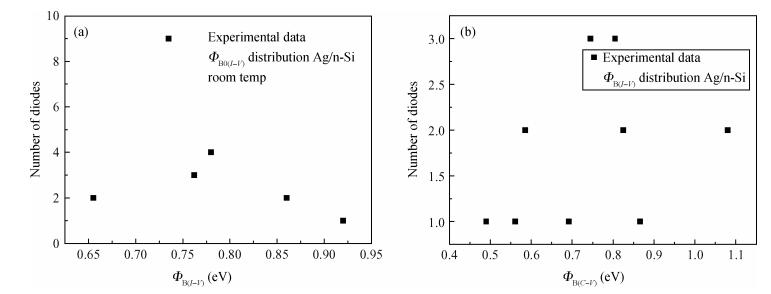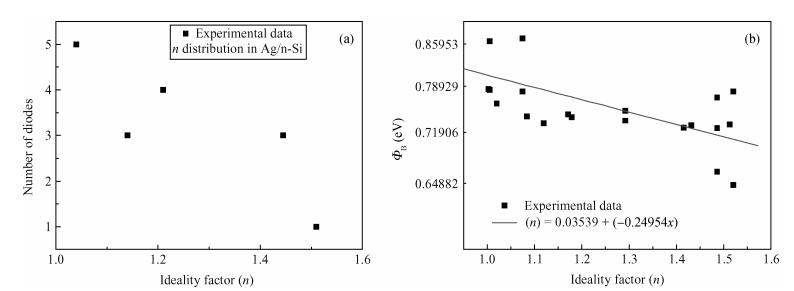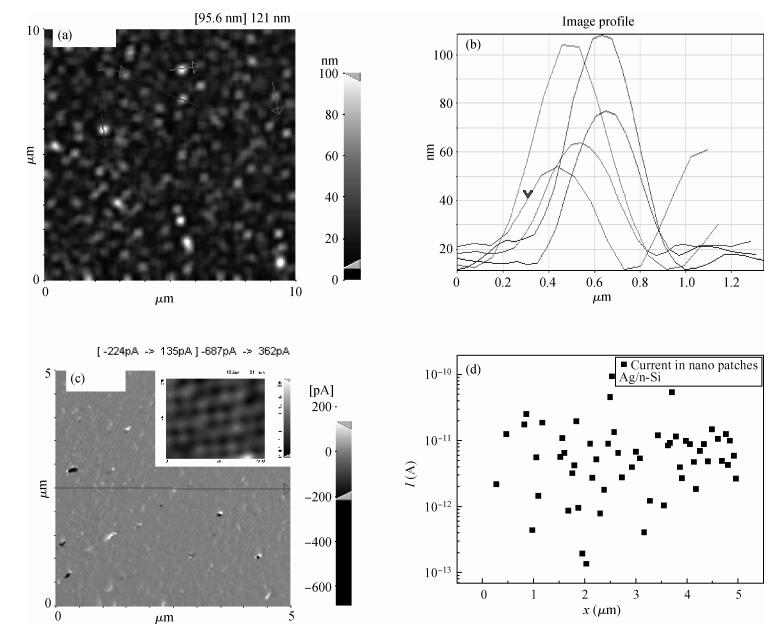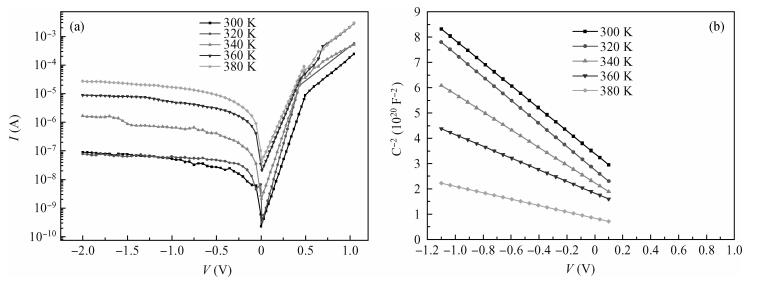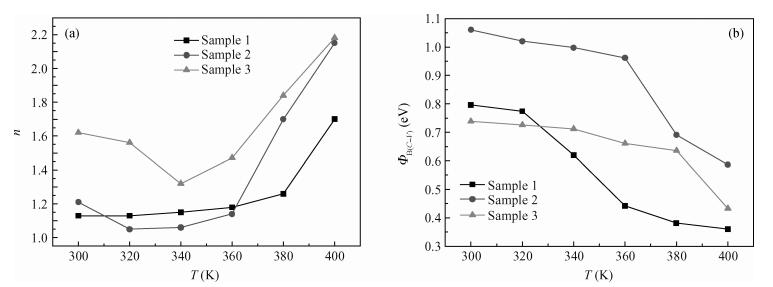| Citation: |
M. A. Yeganeh, R. K. Mamedov, A. J. Novinrooz. Nano inhomogeneity effects on small Ag/n-Si Schottky diode parameters at high temperature[J]. Journal of Semiconductors, 2013, 34(8): 082002. doi: 10.1088/1674-4926/34/8/082002
****
M. A. Yeganeh, R. K. Mamedov, A. J. Novinrooz. Nano inhomogeneity effects on small Ag/n-Si Schottky diode parameters at high temperature[J]. J. Semicond., 2013, 34(8): 082002. doi: 10.1088/1674-4926/34/8/082002.
|
Nano inhomogeneity effects on small Ag/n-Si Schottky diode parameters at high temperature
DOI: 10.1088/1674-4926/34/8/082002
More Information
-
Abstract
Schottky diodes with an Ag/n-Si/W/Cu structure and 100 μm in diameter were studied. Analyzing the silver metal surface coating on the n-Si substrate using a scanning probe microscopy (SPM) device showed a large number of nano patches in the surface with dimensions of 0 to 100 nm. The potential distribution of the patches revealed that the potential of each patch with the neighboring patches was different. The electrical characteristics of the devices were studied between temperature ranges of 300 and 380 K. When the temperature ideality factor approximately increases, the potential barrier height decreases. The potential barrier height was calculated separately from the I-V and C-V characteristics. The main reasons for the significant difference between room temperature and higher temperatures were the differences in patch distribution, the different potentials of each patch, and the interactions between them. The effective potential barrier height depended on the degree of inhomogeneity, and thus the operating potential barrier height in the contact surface was smaller than the average value, and the ideality factor was more than unitary. With the increase in the potential value, the ideality factor becomes close to unitary, and with increasing temperatures, the ideality factor is increased. In this case, the maximum potential barrier height accrues at a greater distance from the metal contact. For this reason, at high temperatures the average value of the potential barrier height is smaller. Moreover, with increasing temperature, the ideality factor is increased. -
References
[1] Schottky W. Halbleitertheorie der sperrschicht. Natur Wissen Chaften, 1938, 26:843 doi: 10.1007/978-94-009-0657-0_4[2] Mott N F. Note on the contact between a metal and an insulator or semiconductor. Proc Cambridge Philos Soc, 1938, 34:568 doi: 10.1017/S0305004100020570[3] Bardeen J. Surface states and rectification at a metal semiconductor contact. Phys Rev, 1947, 71:717 doi: 10.1103/PhysRev.71.717[4] Tung T. Electron transport of inhomogeneous Schottky barriers. Appl Phys Lett, 1991, 58(24):2821 doi: 10.1063/1.104747[5] Sullivan J P, Tung R T, Pinto M R, et al. Electron transport of inhomogeneous Schottky barriers:a numerical study. J Appl Phys, 1991, 70:7403 doi: 10.1063/1.349737[6] Tung R T. Recent advances in Schottky barrier concepts. Mater Sci Eng, 2001, 35:1 doi: 10.1016/S0927-796X(01)00037-7[7] Tung R T, Brilson L J. Contacts to semiconductors. New Jersey:Noyes Publishers, 1993[8] Werner J H, Guttler H H. Barrier inhomogeneities at Schottky contacts. J Appl Phys, 1991, 69:1522 doi: 10.1063/1.347243[9] Monch W. Metal-semiconductor contacts:electronic properties. Surf Sci, 1994, 299/300:928 https://www.pubfacts.com/detail/28922484/Characterization-of-Edge-Contact-Atomically-Resolved-Semiconductor-Metal-Lateral-Boundary-in-MoS2[10] Monch W. Barrier heights of real Schottky contacts explained by metal-induced gap states and lateral in homogeneities. J Vac Sci Technol B, 1999, 17:1867 doi: 10.1116/1.590839[11] Schmitsdorf R F, Monch W. Influence of the interface structure on the barrier height of homogeneous Schottky contacts. European Physical Journal B-Condensed, 1999:457 http://cat.inist.fr/?aModele=afficheN&cpsidt=1814364[12] Sato T, Kasai S, Okada H, et al. Electrical properties of nanometer-sized Schottky contacts on n-GaAs and n-InP formed by in situ electrochemical process. Jpn J Appl Phys, 2000, 39:4609 doi: 10.1143/JJAP.39.4609[13] Ayyildiz E, Cetin H, Horvath Z J. Temperature dependent electrical characteristics of Sn/p-Si Schottky diodes. Appl Surf Sci, 2005, 252:1153 doi: 10.1016/j.apsusc.2005.02.044[14] Osvald J, Horvath Z J. Theoretical study of the temperature dependence of electrical characteristics of Schottky diodes with an inverse near-surface layer. Appl Surf Sci, 2004, 234:349 doi: 10.1016/j.apsusc.2004.05.046[15] Nuhoglu C, Ozerden E, Turut A. The dependence of I-V and C-V characteristics on temperature in the H-terminated Pb/p-Si (100) Schottky barrier diodes. Appl Surf Sci, 2005, 250:203 doi: 10.1016/j.apsusc.2004.12.047[16] Farag A A M, Ashery A, Ahmed E M A, et al. Effect of temperature, illumination and frequency on the electrical characteristics of Cu/p-Si Schottky diode prepared by liquid phase epitaxy. Journal of Alloys and Compounds, 2010, 495:116 doi: 10.1016/j.jallcom.2010.01.098[17] Karatas S, Altındal S, Turut A, et al. Electrical transport characteristics of Sn/p-Si Schottky contacts revealed from I-V-T and C-V-T measurements. Physica B, 2007, 392:43 doi: 10.1016/j.physb.2006.10.039[18] Shah M, Sayyad M H, Karimov K S, et al. Investigation of the electrical properties of a surface-type Al/NiPc/Ag Schottky diode using I-V and C-V characteristics. Physica B, 2010, 405:1188 doi: 10.1016/j.physb.2009.11.034[19] Reddy M B, Kumar A A, Janardhanam V, et al. Current-voltage-temperature (I-V-T) characteristics of Pd/Au Schottky contacts on n-InP (111). Current Appl Phys, 2009, 9:972 doi: 10.1016/j.cap.2008.10.001[20] Yüksel Ö F. Temperature dependence of current-voltage characteristics of Al/p-Si (100) Schottky barrier diodes. Physica B, 2009, 404:1993 doi: 10.1016/j.physb.2009.03.026[21] Huang W C, Chen C C. Electrical characteristics and in homogeneous barrier analysis of Al/NPB/p-Si Schottky diodes. Microelectron Eng, 2011, 88:287 doi: 10.1016/j.mee.2010.11.023[22] Tunc T, Altindal S, Uslu I, et al. Temperature dependent current-voltage (I-V) characteristics of Au/n-Si (111) Schottky barrier diodes with PVA (Ni, Zn-doped) interfacial layer. Materials Science in Semiconductor Processing, 2011, 14:139 doi: 10.1016/j.mssp.2011.01.018[23] Aydın M E, Gullu O, Yıldırım N. Temperature dependence of current-voltage characteristics of Sn/p-Si Schottky contacts. Physica B, 2008, 403:131 doi: 10.1016/j.physb.2007.08.089[24] Nuhoglu C, Gulen Y. The dependence of I-V and C-V characteristics on temperature in the H-terminated Pb/p-Si(100) Schottky barrier diodes. Vacuum, 2010, 84:812 doi: 10.1016/j.vacuum.2009.10.049[25] Osvald J. Temperature dependence of barrier height parameters of inhomogeneous Schottky diodes. Microelectron Eng, 2009, 86(1):117 doi: 10.1016/j.mee.2008.10.006[26] Maeda K. Nonideality of Au/Si and Au/GaAs Schottky barriers due to process-induced defects. Appl Surf Sci, 2006, 252:5659 doi: 10.1016/j.apsusc.2005.07.074[27] Naik S S, Reddy V R. Electrical transport characteristics and deep level transient spectroscopy of Ni/V/n-InP Schottky barrier diodes. J Nano-Electron Phys, 2011, 3(1):1048 http://www.oalib.com/paper/2847224[28] Desai R R, Lakshminarayana D, Sachdeva R, et al. Barrier inhomogeneities of Al/p-In2Te3 thin film Schottky diodes. J Nano-Electron Phys, 2011, 3(1):995 http://www.academia.edu/13399590/Thin_Film_Deposition_Methods_for_CuInSe_2_Solar_Cells[29] Al-Heniti S, Badran R I, Umar A, et al. Temperature dependant structural and electrical properties of ZnO nanowire networks. Journal of Nanoscience and Nanotechnology, 2011, 11:1 doi: 10.1166/jnn.2011.3839[30] Naik S S, Reddy V R. Temperature dependency and current transport mechanisms of Pd/V/n-type InP Schottky rectifiers. Adv Mat Lett, 2012, 3(3):188 doi: 10.5185/amlett[31] Khannaa S, Neeleshwara S, Noorb A. Current-voltage-temperature (I-V-T) characteristics of CR/4H-SIC Schottky diodes. Journal of Electron Devices, 2011, 9:382 http://www.jeldev.org/9Shaweta.pdf[32] Mamedov R K. Contacts metal-semiconductor with electrical spots field. Baku State University Press, 2003:1 doi: 10.1134/S1063782611080227 -
Proportional views





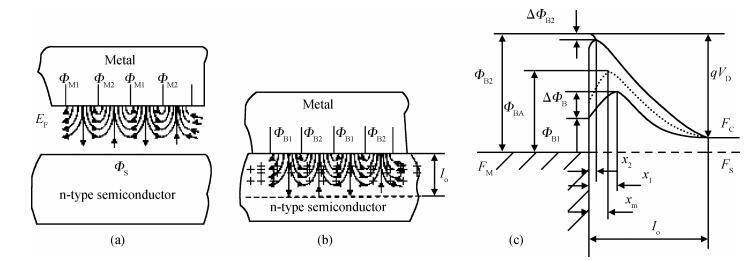
 DownLoad:
DownLoad:
